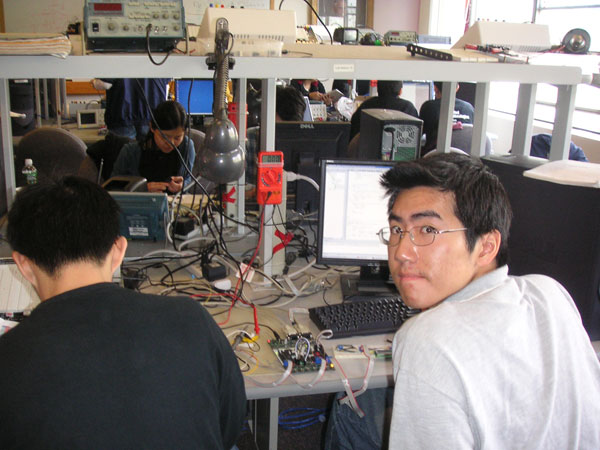
We started out wanting to make a 5.25" drive bay mountable, fully standalone PC temperature monitoring and control unit. In the end, we got real close to the original design. While it isn't mountable to a drive bay, the overall size of the unit suggests that it's entirely possible, especially if a PCB is used instead of a breadboard. Sadly, we do not have access to custom PCBs. Overall, we managed to monitor 2 temperatures and control the fan speeds of 2 fans, as well as monitor the fan speed. The I/O interface that was initially proposed was accomplished, including pushbuttons, HyperTerminal, LCD display, LEDs and alarm speaker. In addition, we added the RF wireless remote control, which was a non-trivial addition to the design. On top of this, the project was kept well within budget, and also below the price of similar units on the market. All in all, this project was a success!
RF conflict: there were several groups using the 433MHz receiver/transmitter set from radiotronix and we this presented a problem when multiple groups were transmitting/receiving, especially towards the end of the project. In order to resolve this conflict, we walked the lab to inform others of our tranmissions, and also took note of other groups who we transmitting.
No bribery was accepted during the course of the final project.
During the brainstorming of project ideas before the actual project design, we considered several features of the unit. We chose to implement both voltage regulation and PWM fan control despite the superiority of PWM fan control, and discussed the pros and cons of both methods.
We accepted the suggestion from TAs to add a wireless interface to our overall design to enhance functionality and increase its complexity. We also accepted help from TAs to understand the implementation details of the fan tachometer readings, as well as usage of relays as the voltage source switches.
Cornell has a diversified community. The ECE department is even more diversified with different races, nationality, gender and religion. We observed no discrimination in this class and people do respect individual differences.
We followed basic laboratory safety rules. Dangerous equipment such as the soldering iron were carefully used.
Our wireless RF transmission falls under Part 15 of the FCC regulations, which lays out the rules and regulations involved with unlicensed transmissions. Our project complies with these regulations, as:
- We only constructed 1 transmitter, less than the limit of 5.
- We did not cause interference with licensed radio communications as the frequency of 433MHz was used, which isn't being used by any known licensed radio communications in the area.
- Transmissions were only broadcast when needed.
- FCC regulations only require "homebuilt" wireless devices to to comply to the best of the builder's extent, and this is certainly the case here.
Due to the decision to use protoboards rather than the STK-500, we were able to save a significant amount of money that would be otherwise caused us to exceed the budget due to our usage of 2 MEGA32 MCUs. Also, we were able to sample almost all the hardware that we didn't already have. We also had in our possessions a wealth of hardware devices, which didn't add to the cost.
| Item | Unit Price | Quantity | Total Cost | Comments |
|---|---|---|---|---|
| Atmel MEGA32 MCU | $8 | 2 | $8 | Found one, priced one |
| Protoboard | $5 | 2 | $10 | |
| LCD display | $8 | 1 | $8 | |
| RS232 connector | $2 | 1 | $2 | |
| Radiotronix RF transmitter/receiver set | $8 | 1 | $8 | |
| MAX233ACPP | $0 | 1 | $0 | Sampled from MAXIM |
| MAX4053 triple 2:1 Analog MUX | $0 | 1 | $0 | Sampled from MAXIM |
| OMRON G6EK-134P-ST-US-DC12 SPDT relay | $0 | 2 | $0 | Sampled from OMRON |
| 4N35 optoisolator | $0 | 9 | $0 | Sampled from Fairchild Semiconductors |
| 3-pin fan connector | $0 | 2 | $0 | Found it |
| Breadboard | $0 | 2 | $0 | Had it |
| NS LM358 dual opamp | $0 | 1 | $0 | Had it |
| 5K trimpots | $0 | 2 | $0 | Had it |
| Resistors, Capacitors, Transistors, Diodes, LEDs LM34 |
$0 | Too Many! | $0 | Free lab parts |
| Total | $36 | Within Budget!!! | ||

Design conceptualization - Sihan Goi & Edward Lo
Design Research - Sihan Goi
Software coding - Edward Lo
Hardware design/building - Sihan Goi
Software documentation/state diagrams - Edward Lo
Hardware documentation/schematics - Sihan Goi
Hardware/Software Integration - Sihan Goi & Edward Lo
Testing/Troubleshooting/Debugging - Sihan Goi & Edward Lo
Website report - Sihan Goi
